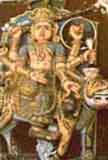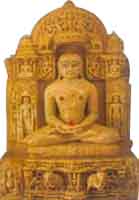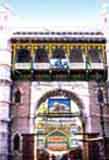| |
|

|
| HINDUISM
:
Most
Indians are Hindus. Hinduism goes back to a hoary antiquity.
Its earliest manisfestation is seen in the Rig Veda, the
oldest religious text in the world, whose principal divinities
were, among others, Indra, the king of gods; Varuna, the
omnipresent god of wind; Surya, the sun god;
|
 Hindu
Temple
Hindu
Temple |
 Hindu
Godess
Hindu
Godess |
Agni,
the fire god; and Yama, the lord of the dead in northern
India and spread out to all parts of the sub-continent,
their religious beliefs, philosophy, and pantheon underwent
gradual transformation. Besides the five principal
cult divinities, Surya,Shiva,Vishnu,Ganesha, and Devi, numerous
popular cults, local hero-spirits, and minor deities formed
integral parts of the Hindu pantheon. In Rajasthan, the
temples are all dedicated to these cult divinities with
the sole exception of the Brahma temple on the bank of the
Pushkar lake.
|
|
JAINISM
:
Jainism,
the religion of the Jinas or "Conquerors", was
founded by Mahavira, in the 6th century BC in Bihar, eastern
India. It has a strong and visible presence in Rajasthan,
with about 2 percent of its population, mostly rich and
influential businessmen and officials, as followers.
Using
their position and wealth they built many beautiful temples,
hospices, and repositories of books and manuscripts from
anciSent times.
|

Mahavira
|
|
The
two main sects of Jinism are the Digambers, the "sky-clad"
ones, and the Svetambaras, the "white clad" ones.
The latter believe in the original canonical texts and follow
them scrupulously while the former do not. Jain believe
in salvation through successive rebirths.
|
CHRISTIANS
:
There
is a very small population of Christians in Rajasthan, amounting
to only 0. 12% of the population. They are found predominantly
in Ajmer and Jaipur, where there are several Catholic and Protestant
churches. The Buddhist population is negligible in Rajasthan,
representing only 0.01% of the population.
ISLAM
:
|
Rajasthan
has had a Muslim population from the time of the Ghori invasion
in 1193.A mystic Islamic group called Sufis,became very
popular in medieval India at the same time as its Hindu-oriented
counterpart, the Bhakti (devotion to God) movement.
Both were products of the unique interaction between Hinduism
and Islam during the 14th and 15th centuries .
|
 |
 Ajmer
Sharif
Ajmer
Sharif |
One
of the world's greatest Sufi shrines lies in Rajasthan.
It is that of the Sufi Saint,Khwaja Moinuddin Chishti (1142-1256
A.D.), a direct descendant of Prophet Muhammad's son-in-law,
Ali. He came to Ajmer during the reign of Prithviraj Chauhan,
who gifted the saint with the land on which his shrine now
stands. At the age of 114, the saint locked himself in his
cell to pray. Six days later his disciples broke open the
door and found the Khwaja Saheb dead.That is why his urs
(feast) is celebrated for six days. His dargah (mausoleum)
is the most popular Muslim pilgrimage center in the
subcontinent. Hindus, Muslims, Sikhs,
and Jains alike believe that this benevolent Sufi Saint.
|
|
|




